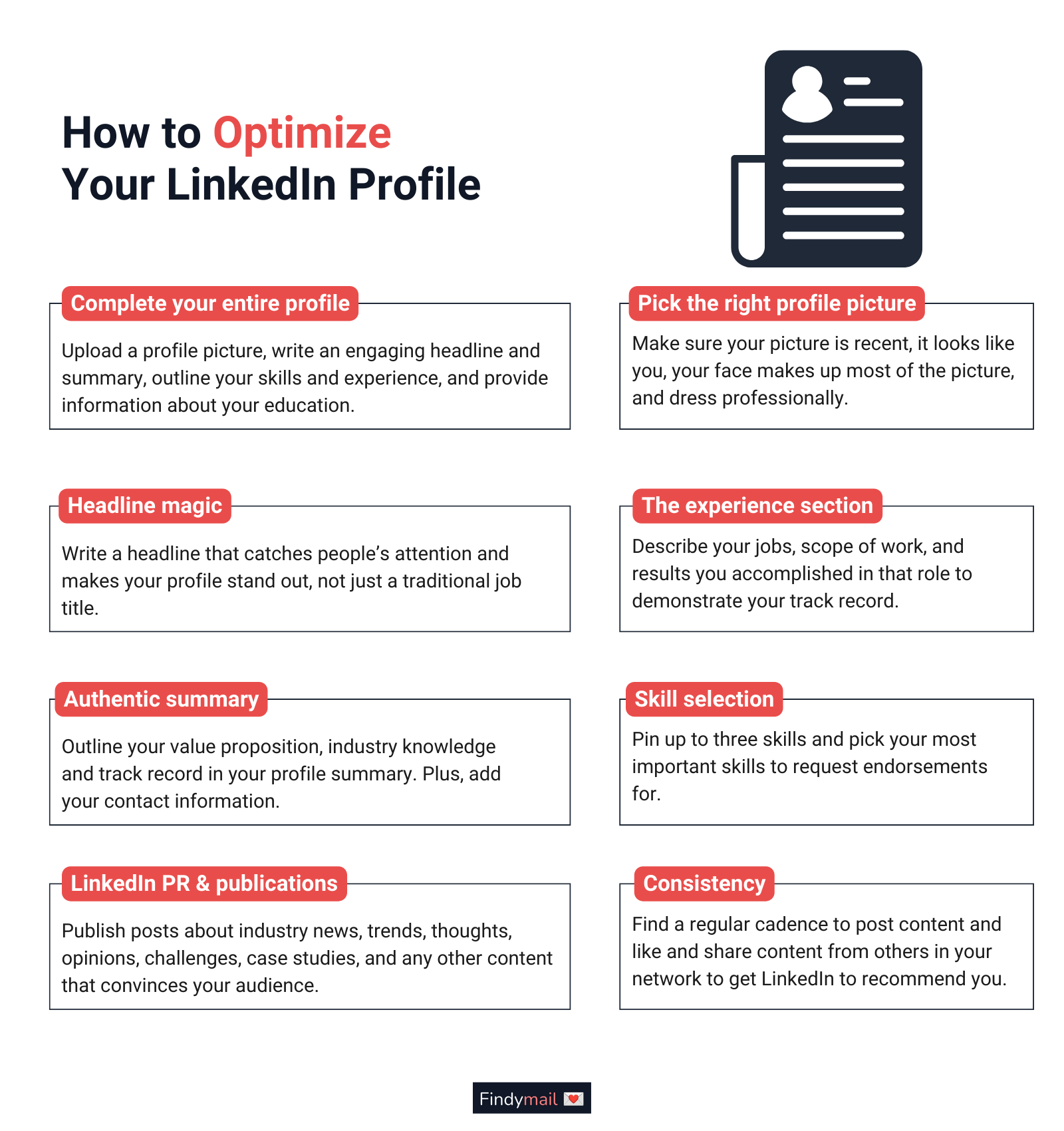LinkedIn is fantastic for lead generation. However, to contact these leads, you’ll need their email addresses, InMails, or first-degree connections. Ultimately, you’ll need to grow your network.
Because of this, you’ll need to optimize your LinkedIn profile. Not only does this help you show up in other users’ feeds and create more connections, but it also adds the credibility that leads want to see when your email lands in their inbox.
With that in mind, let’s look at the best ways to optimize your LinkedIn profile in 2024!

#1 Complete Your Entire LinkedIn Profile
Before you take any steps to optimize your profile, you should ensure you complete all the information.
So, you’ll need to:
- Upload a profile picture
- Write an engaging headline and summary
- Outline your skills and experience
- Provide information about your education
Completing your profile forms the basis of your optimization efforts, and with a complete profile, you’ll grow your network faster and easier and get more opportunities from the platform.
#2 Use the Right Profile Picture
It’s true; first impressions last. And your LinkedIn profile picture will likely be the first thing other users see.
Make sure your picture is recent, it looks like you, your face makes up most of the picture, and you dress like you would at work. And speaking of photos, you should also add a background image to your profile that could help you stand out from the crowd.
Here, you can see how Carolyn Schuster perfected her profile picture:
#3 Optimize Your LinkedIn Profile by Making Your Headline Go Further than the Job Title
Many users use their job titles as a headline. This isn’t optimal since your headline is one of the first things people will see. Write a headline that catches people’s attention and makes your profile stand out.
(This is especially important if you have a sales job. No lead likes to see “Account Executive at [XYZ].” They’ll be expecting a pitch right away.)
To do this, use your headline as a brief primer into who you are, what you do, and what value you can offer. Also, aim to use keywords relevant to your industry to make your profile appear in more searches.
Look at how Ben A. Wise uses his headline to show what he does and what value he offers:
#4 Write an Authentic Summary
Next up, you’ll write an engaging and authentic summary. To do this, avoid merely listing your skills and experience.
Instead, tell your story and show people who you are and what you care about. You should also outline your value proposition. So, instead of telling people what your skills are, tell them how your skills can make a difference instead.
Also, as with your headline, you should add some industry-related keywords. To generate leads in a specific industry, reference your industry knowledge. Put your expertise first and prove that you have a track record.
Finally, add your contact information to encourage people to connect with you.
Here, you can see how Desiree Thompson crafted a summary that tells a story while highlighting her communication skills.
#5 Optimize Your LinkedIn Profile by Getting Your Experience Section Right
Once you’ve optimized your profile picture, headline, and summary, you should also do so for your experience section. Here, the first thing you should do is optimize your job titles. Job titles might vary in different companies and industries, so ensure your job title translates across industries.
When you’ve optimized your job title, you should also describe relevant jobs you’ve had. Briefly outline your key responsibilities and your scope of work. More importantly, consider sharing the results you’ve achieved in these jobs.
If you’re on LinkedIn to generate leads, don’t talk about what you did at your job daily. Instead, talk about the successes your customers have seen thanks to your matching them with the perfect solution.
#6 Think about Your Skills
LinkedIn allows you to add up to 50 skills to your profile, so take advantage of this opportunity. Keep in mind, though, that you don’t need to fill all 50 spaces and, as such, these skills should be relevant to what you do and what you can contribute.
You can also pin up to three skills, so here you’ll pin the most important skills you’d like to highlight. One of the main advantages of adding your skills is that it provides more depth to the information you’ve already offered in your headline and summary.
Another advantage of adding your skills is that it allows other users to endorse these skills. This increases your credibility on the platform and makes it easier to grow your network. It’s important to remember that you should manage these endorsements properly to reflect what you can do.
#7 Use the Publications Section to Your Advantage
LinkedIn provides a Publications section where you can publish your content. Here, you can post anything from industry news and trends, your thoughts and opinions on specific industry-related aspects, challenges you faced and how you solved them, case studies, or any other content that adds value for your audience. This is an effective strategy to show your skills and experience.
Apart from creating your own content, you can also share relevant content with your network. This way, you’ll add value without necessarily taking the time and effort to create your content. As a bonus, you’ll also show up in your network’s feeds more often.
Don’t forget to use content to warm up your leads. Say you find a lead’s email address on LinkedIn with Findymail.
What’s next?
Establish the initial contact and send them a link to one of your relevant posts. Ideally, you want to illustrate how you’ve helped others resolve similar challenges in a similar industry.
Not only will they get value out of your email, but you’ll also encourage them to connect with you on LinkedIn and give them a sense of your personality.
#8 Be Consistent
Find a regular cadence to post content and like and share content from others in your network. This results in your profile showing up more in others’ feeds, which keeps you at the top of users’ minds. And, as your traction on the platform increases through consistency, you’ll have access to far more opportunities.
Get Your LinkedIn Profile on Point Now
At the end of the day, you should remember your audience: Who are they? What do they struggle with? How can you prove that you can help them?
If you approach LinkedIn optimization from that standpoint, you’ll have no trouble optimizing (and maximizing) your profile’s influence.






